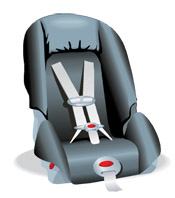

What to do with a used car seat
With recycling options limited, countless seats end up in landfills
Many of the 12 million car seats Americans buy every year eventually end up in a landfill. Recycling would reduce the amount of car seat landfill waste, but it's in effect in limited places. Some states and communities offer local recycling of some seat parts, though there isn't a large-scale effort to manage this waste. One reason: Stripping down seats and separating the various materials for recycling is a highly manual (aka expensive) process.
Consumer Reports knows all about the limited recycling options. There's no local outlet for recycling the car seats we've tested, though we have found a place that takes the Styrofoam seat lining of the seats.
The best alternative is to recycle as much of the seat as you can yourself. Before you do the work, ask the local department of public works whether the plastic from the seat is accepted in the local recycling program— some seats have metal molded in.
If you're ready to retire a seat, use these tips, courtesy of the recycling program in Ann Arbor, Mich. They're especially important, because data shows that you'll go through three car seats for each of your kids over the years.
1. Use scissors to cut off the fabric, foam padding, and harness straps from the seat.
2. Use a Phillips-head screwdriver to remove as much metal as possible. Some cannot be removed easily.
3. Remove the car seat cover and any padding underneath it.
4. Discard the fabric, foam padding, straps, and mixed metal/plastic pieces and small
plastic pieces.
5. Mark the plastic as expired or unsafe.
6. Recycle the bulky plastic body and all metal pieces.
A number of organizations offer periodic car-seat recycling programs or continuously accept seats to recycle. Some will strip the seats for you. Otherwise, look into various community programs.
If you find that the only practical alternative is to dispose of the seat in the trash, remove the straps and get rid of them separately, or cut them so that the seat can't be used again.
Don't buy or sell used car seats
While it is nice to share and reuse baby items, car seats are one product you shouldn't reuse, especially if you don't know its history. A seat that has been involved in a crash, for instance, could be dangerous to use, and you might not know whether a manufacturer has recalled a seat. What's more, the components used in the typical car seat deteriorate and weaken over time. That's why car seats have an expiration date stamped on the back, typically six years from the manufacture date.
Source: Consumer Reports (2013), Consumer Reports News: October 17, 2013, by Liza Barth
Published 6-6-14